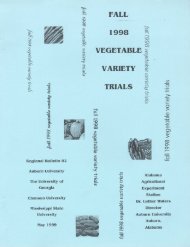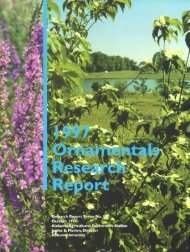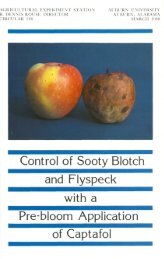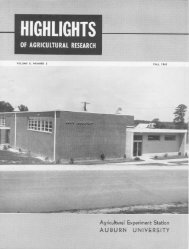MARKETING CHRISTMAS TREES - Auburn University Repository
MARKETING CHRISTMAS TREES - Auburn University Repository
MARKETING CHRISTMAS TREES - Auburn University Repository
You also want an ePaper? Increase the reach of your titles
YUMPU automatically turns print PDFs into web optimized ePapers that Google loves.
<strong>MARKETING</strong> <strong>CHRISTMAS</strong> <strong>TREES</strong> II<br />
the last few years. These little, standardized, good quality, modest-priced<br />
trees seem to be growing in favor for small apartments,<br />
families without children, and miscellaneous decorative uses.<br />
They represent most of the small tinted trees reported in Table 4.<br />
While a sixth of all trees were tinted, over a fourth of the small<br />
trees were so treated. No cedar, pine, or cypress trees of any size<br />
were reported to have been tinted by producers, nor were any<br />
medium-sized or larger spruce or fir tinted before reaching the<br />
retailer. Thus, except for ornamentals, tinting became the responsibility<br />
of the retailer or of the customer, who at times had his<br />
tree tinted by a custom operator.<br />
Since the amount of paint required for tinting trees tends to<br />
increase geometrically with the size as determined by height, it<br />
seems probable that the costs of tinting may become too great<br />
with large trees except for special uses. It is noted that none of<br />
the trees classified as very large were reported to have been<br />
tinted. Apparently, the larger the tree the more the retailer was<br />
inclined to shift the tinting responsibility to the customer, or to<br />
perform this service only on the customer's order.<br />
Except for the ornamentals, which were black spruce and<br />
tinted on arrival, there seemed to be no particular preference as<br />
to the species used when tinting was sought. Silver tinting was<br />
the most common color used by retailers. However, some instances<br />
were noted of other tints being used. Ornamentals usually<br />
came in green, silver, white, or pink, with silver the most common<br />
and pink the most rare.<br />
No chain store retailer was found who tinted trees after receiving<br />
them, even though chain stores, in general, were the most<br />
important retailers of tinted ornamentals, Table 5. Other food<br />
TABLE 5. PERCENTAGE OF ALL <strong>CHRISTMAS</strong> <strong>TREES</strong> SOLD THAT WERE TINTED, BY<br />
TYPE OF RETAILER AND BY SIZE OF TREE, 11 SELECTED MARKETS,<br />
ALABAMA, 1956<br />
Size of tree<br />
Type of retailer Very All<br />
Small Medium Large large sizes<br />
Pct. Pct. Pct. Pct. Pct.<br />
Chain stores 60.1 0.0 0.0 0.0 31.2<br />
Other food stores 23.9 8.4 1.3 .0 7.5<br />
Civic clubs 16.7 24.1 .7 .0 17.5<br />
Other sellers 15.0 12.6 9.1 .0 12.5<br />
Total - 27.6 13.9 4.8 0.0 17.3<br />
1 For description of usual heights of respective size groups, see Table 1.
















